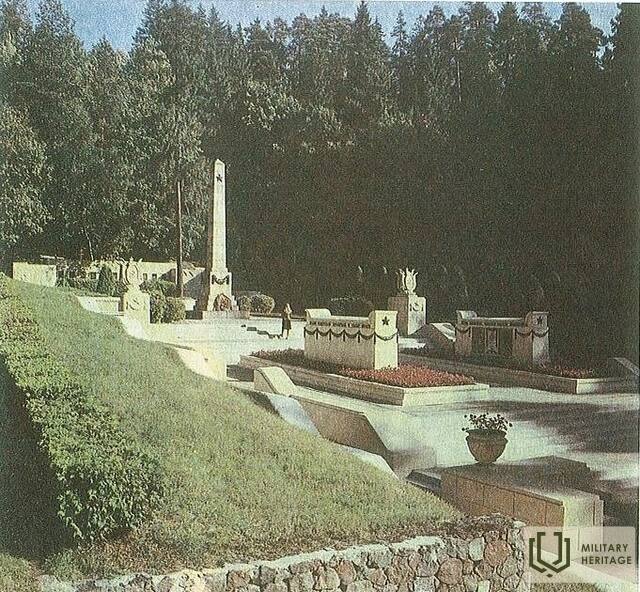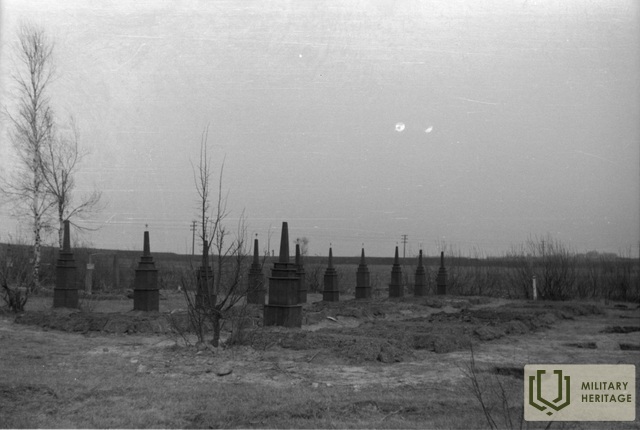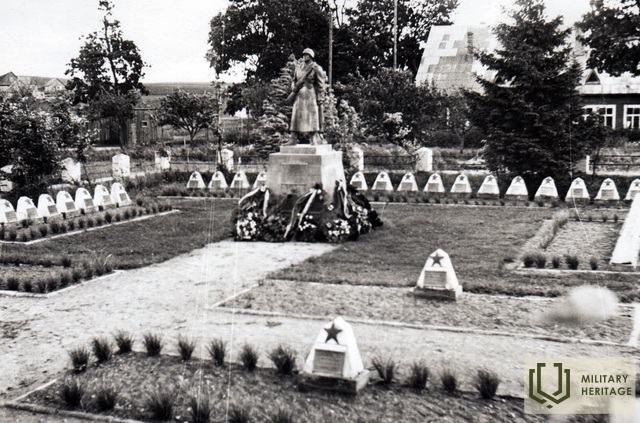Burial sites of Soviet soldiers of World War II: (I) charge
II World War II

The burial grounds of Soviet soldiers of World War II are not only cemeteries, but also memorials. To be more precise, they are primarily memorials, where bodies were used as “building material” for constructing meanings favorable to the regime and spreading its propaganda. Fallen soldiers had already been buried once before in wartime, often in places that happened to be available under circumstances – in forests, fields, courtyards, city squares, local cemeteries. Such were the realities of wartime. However, in 1945, secondary burial grounds for soldiers began to be established in occupied Lithuania. The reasons were utilitarian: it was necessary to solve the issue of optimizing the number of graves and their maintenance, and this was done by merging several or a dozen graves into one. The second reason was ideological – they were used to create and consolidate the myth of the Soviet Great Patriotic War . Secondary burial grounds were no longer created spontaneously, but in accordance with the best traditions of creating memorials. They were usually arranged at the primary burial sites of soldiers, choosing from them the most suitable for memorial practices in terms of their location. The transformation of primary burial sites into secondary ones fundamentally changed the object itself. They became less dependent on historically established circumstances and came closer to what can be called an ideal memorial site. The pursuit of the formation of these sites in Lithuania continued until 1956. Below are several cross-sections illustrating that these sites were created and exploited by their creators as instruments of memory construction, propaganda and soft power.
Localization . Let us return to the idea that the transformation of primary burial grounds into secondary ones fundamentally changed the object itself. First of all, they changed their localization and from fields, forests and village objects became objects of cities and towns. In 1973, there were 176 cemeteries of Soviet soldiers of the Great Patriotic War in Lithuania: about 50 percent. of them were in cities or their outskirts, 38 percent. in towns, 11 percent. in villages and one in a forest. This is also related to another trend - the localization of secondary sites was perfectly matched to the administrative-territorial division of the Lithuanian SSR. In 1949, the Lithuanian SSR had 41 counties and all county centers (central settlements of counties) had their own cemeteries of Soviet soldiers of the Great Patriotic War . From the chaotically scattered primary burial grounds, a territorial and propaganda network was formed that evenly covered the whole of Lithuania.
“Red Corner” . Around 1956. the first and largest wave of reburials of soldiers subsided. However, the bodies continued to flow. And these were not only the bodies of soldiers and not only those who died in World War II. (a) Around 1954. the Lithuanian SSR intensified the transfer of the remains of Soviet partisans to the cemeteries of Soviet soldiers of the Great Patriotic War . At least 13 percent. of such cemeteries were laid to rest next to the soldiers or at least Soviet partisans were also mentioned on the memorial plaques of the cemeteries. (b) At least 17 percent. of these places were buried by persons who died in the whirlpool of the Lithuanian partisan war of 1945–1953 – Soviet Union soldiers, partisans, Soviet activists, their family members. (c) In the 70s–90s. Soviet Union soldiers who died under various circumstances and who no longer belonged to the generations that could have participated in World War II were buried here. For example, victims of the 1979–1989 war in Afghanistan. (d) Veterans of the Great Patriotic War who died after 1945 were also buried. There were other groups: (e) those who fought on the side of the Bolsheviks or contributed to them during the Lithuanian Independence Wars of 1918–1920, or (f) the bodies of Soviet collaborators killed by Lithuanians during the June Uprising of 1941.
The cemetery of Soviet soldiers of the Great Patriotic War , on the one hand, became a shelter for other bodies, on the other hand, those other bodies added new meanings to the place itself. Therefore, the cemetery of Soviet soldiers of the Great Patriotic War is a somewhat more complex structure in its actual content than its name suggests. Bodies that died in different eras and under different circumstances in this place intertwined into one idea that rises above history, propagandistically testifying to the immortality of revolutionary thought and the victory of the Soviet system in general. This was the Soviet “red corner” in the landscape – the materialization of specific stories and Soviet myths through bodies, memorial forms and records.
More information sources
- Salvijus Kulevičius, "In the Traps of the Soviets: Soviet World War II Military Burial Sites in Lithuania. The Genesis", in: Trimarium: The History and Literature of Central and Eastern European Countries , 2023, no. 4, p. 11–46, available online: https://ojs.trimarium.info/trimarium/article/view/tri.2023.0104.01 .
- Salvijus Kulevičius, “Places”, in: Soldiers. Concrete. Myth. Burial Places of Soviet Soldiers of World War II in Lithuania , Vilnius: Vilnius University Press, 2016, pp. 57–115.






